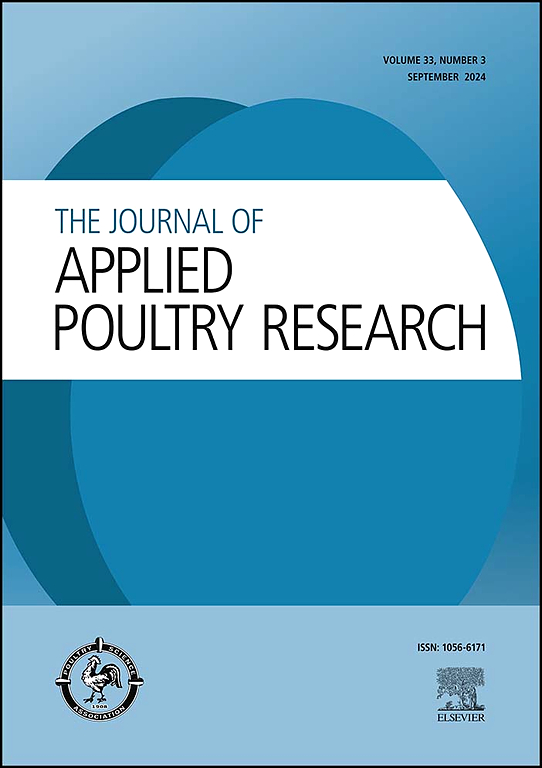Optimization of a loop-mediated isothermal amplification (lamp) assay for the rapid detection of Clostridium perfringens
IF 2
3区 农林科学
Q2 AGRICULTURE, DAIRY & ANIMAL SCIENCE
引用次数: 0
Abstract
This study developed and optimized a loop-mediated isothermal amplification (LAMP) assay for the rapid, sensitive, and specific detection of Clostridium perfringens (C. perfringens), a key pathogen in necrotic enteritis in poultry, causing significant global economic losses. We designed two sets of LAMP primers, ID7 and ID22, targeting the cpa gene of C. perfringens. The CP-LAMP assays were optimized for temperature, time, and primer concentration. We conducted inclusivity tests on 55 C. perfringens strains and exclusivity tests on six other Clostridium species strains and 33 non-Clostridium strains (Escherichia coli, Campylobacter, and Salmonella). Sensitivity was evaluated using serially diluted genomic DNA from C. perfringens ATCC 13124 and compared to PCR. The optimal primer concentrations were 8 μM F3/B3 and 48 μM FIP/BIP. Reactions were performed at 63°C for 30 min. Both primer sets achieved 100 % inclusivity and 88.33 % and 100 % exclusivity for other Clostridium and non-Clostridium isolates, respectively. The CP-LAMP assay's sensitivity and specificity were comparable to PCR, enhancing surveillance and management of necrotic enteritis in poultry farms, potentially reducing its economic impact.
环状介导等温扩增(灯)法快速检测产气荚膜梭菌的优化
本研究建立并优化了一种环介导的等温扩增(LAMP)方法,用于快速、灵敏、特异地检测产气荚膜梭菌(C. perfringens)。产气荚膜梭菌是禽类坏死性肠炎的关键病原体,在全球范围内造成了重大的经济损失。我们设计了两组针对产气荚膜荚膜菌cpa基因的LAMP引物ID7和ID22。优化了CP-LAMP检测的温度、时间和引物浓度。我们对55株产气荚膜梭菌进行了包容性试验,对其他6株梭菌和33株非梭菌(大肠埃希菌、弯曲杆菌和沙门氏菌)进行了排他性试验。采用连续稀释的产气荚膜荚膜杆菌ATCC 13124基因组DNA进行敏感性评估,并与PCR进行比较。最佳引物浓度为8 μM F3/B3和48 μM FIP/BIP。反应在63°C下进行30分钟。两组引物对其他梭状芽孢杆菌和非梭状芽孢杆菌分离物分别达到100%的包容性和88.33%和100%的独占性。CP-LAMP检测的敏感性和特异性与PCR相当,加强了家禽养殖场对坏死性肠炎的监测和管理,潜在地减少了其经济影响。
本文章由计算机程序翻译,如有差异,请以英文原文为准。
求助全文
约1分钟内获得全文
求助全文
来源期刊

Journal of Applied Poultry Research
农林科学-奶制品与动物科学
CiteScore
4.10
自引率
10.50%
发文量
80
审稿时长
104 days
期刊介绍:
The Journal of Applied Poultry Research (JAPR) publishes original research reports, field reports, and reviews on breeding, hatching, health and disease, layer management, meat bird processing and products, meat bird management, microbiology, food safety, nutrition, environment, sanitation, welfare, and economics. As of January 2020, JAPR will become an Open Access journal with no subscription charges, meaning authors who publish here can make their research immediately, permanently, and freely accessible worldwide while retaining copyright to their work. Papers submitted for publication after October 1, 2019 will be published as Open Access papers.
The readers of JAPR are in education, extension, industry, and government, including research, teaching, administration, veterinary medicine, management, production, quality assurance, product development, and technical services. Nutritionists, breeder flock supervisors, production managers, microbiologists, laboratory personnel, food safety and sanitation managers, poultry processing managers, feed manufacturers, and egg producers use JAPR to keep up with current applied poultry research.
 求助内容:
求助内容: 应助结果提醒方式:
应助结果提醒方式:


